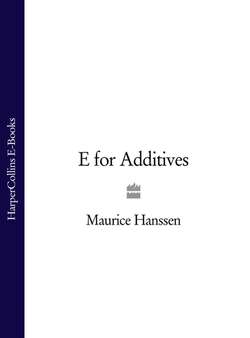Читать книгу E for Additives - Maurice Hanssen - Страница 30
9. Hyperactivity in Children
ОглавлениеA lot of cynicism has been generated about the whole idea of hyperactivity in children. ‘There are no hyperactive children, only hyperactive parents’ is a frequent retort. The evidence is mounting, although with some reservations, that a good deal of so called hyperactivity is, in fact, due to an unstable environment, but that a good deal is due to food. Dr Egger at Great Ormond Street Hospital showed in his series of cases that there were no children who had an adverse effect from additives only. They were always affected by a food as well.
Dr Ben Feingold MD began his work and observations in 1965 on the link between certain foods and additives and the effect on some individuals’ behaviour and their ability to learn. He proposed a diet which cut down on certain additives and eliminated certain foods. Scientific workers are still uncertain as to the validity of the whole of Dr Feingold’s ideas, but there is no doubt that a vast number of hyperactive children, and also asthmatics and those suffering from eczema, have benefitted immeasurably from a sensible and careful adaptation of this diet.
Hyperactive children bring much strain and exhaustion to parents who have to manage offspring who only sleep a few hours; are excitable and impulsive; are very fidgety; have a short attention span; are compulsively aggressive; can hurt themselves and are sometimes very anti-social. All these traits are beyond the control of the children, who may well also suffer from a lack of co-ordination of the muscles. They collide with objects when trying such simple sports as cycling and swimming. Their finer senses, such as their eyes and hands, do not seem to operate together. They have difficulty with buttoning and tieing, writing, drawing and speaking—sometimes they are dyslexic.
As they grow older they become even more active and can easily hurt. Difficulties are experienced with speech, balance and learning, even if the IQ is high. They suffer from excessive thirst and are often prone to respiratory difficulties.
It was to help such parents and children that the Hyperactive Children’s Support Group was formed in 1977. It is now a registered charity. The Secretary is Mrs Sally Bunday, 71 Whyke Lane, Chichester, West Sussex P019 2LD (please enclose an SAE if you would like details of membership). The Group recommends that parents try a diet based on the work of Ben Feingold. First, this means cutting out all food and drink containing synthetic colours or flavours, avoiding glutamates, nitrites, nitrates, BHA, BHT and benzoic acid. Second, for the first four to six weeks, foods containing natural salicylates (like aspirin chemically) should be avoided and then re-introduced one at a time to see if they cause problems. Such foods include almonds, apples, apricots, peaches, plums, prunes, oranges, tomatoes, tangerines, cucumbers, most soft fruits, cherries, grapes and raisins.
The additives that the HACSG recommends should be avoided are:
| E102 | Tartrazine |
| E104 | Quinoline Yellow |
| 107 | Yellow 2G |
| E110 | Sunset Yellow FCF |
| E120 | Cochineal |
| E122 | Carmoisine |
| E123 | Amaranth |
| E124 | Ponceau 4R |
| E127 | Erythrosine |
| 128 | Red 2G |
| E132 | Indigo Carmine |
| 133 | Brilliant blue FCF |
| E150 | Caramel |
| E151 | Black PN |
| 154 | Brown FK |
| 155 | Brown HT |
| El60(b) | Annatto |
| E210 | Benzoic acid |
| E211 | Sodium benzoate |
| E220 | Sulphur dioxide |
| E250 | Sodium nitrite |
| E251 | Sodium nitrate |
| E320 | Butylated hydroxyanisole |
| E321 | Butylated hydroxytoluene |
Plus another antioxidant preservative not used in the UK
| TBHQ | (Monotertiary butylhydroxylquinone) |
Additives which are either dangerous to asthmatics or aspirin-sensitive people, and could reasonably be added to the HACSG listing, or should not be used in food intended for babies or young children are:
| E212 | Potassium benzoate |
| E213 | Calcium benzoate |
| E214 | Ethyl 4-hydroxybenzoate |
| E215 | Ethyl 4-hydroxybenzoate, sodium salt |
| E216 | Propyl 4-hydroxybenzoate |
| E217 | Propyl 4-hydroxybenzoate, sodium salt |
| E218 | Methyl 4-hydroxybenzoate |
| E219 | Methyl 4-hydroxybenzoate, sodium salt |
| E310 | Propyl gallate |
| E311 | Octyl gallate |
| E312 | Dodecyl gallate |
| 621 | Sodium hydrogen L-glutamate (monoSodium glutamate) |
| 622 | Potassium hydrogen L-glutamate (monoPotassium glutamate) |
| 623 | Calcium dihydrogen di-L-glutamate (calcium glutamate) |
| 627 | Guanosine 5’-(diSodium phosphate) |
| 631 | Inosine 5’-(diSodium phosphate) |
| 635 | Sodium 5’-ribonucleotide |
The medical profession still believes that more work is needed with larger trials, but in the meantime such diets are very valuable if you, having adopted them, then reduce the number of forbidden substances and foods so that the child concerned is left with as large a variety as possible, is not kept out of the main stream of childhood fun, and does not suffer from unnecessarily restrictive rules.
